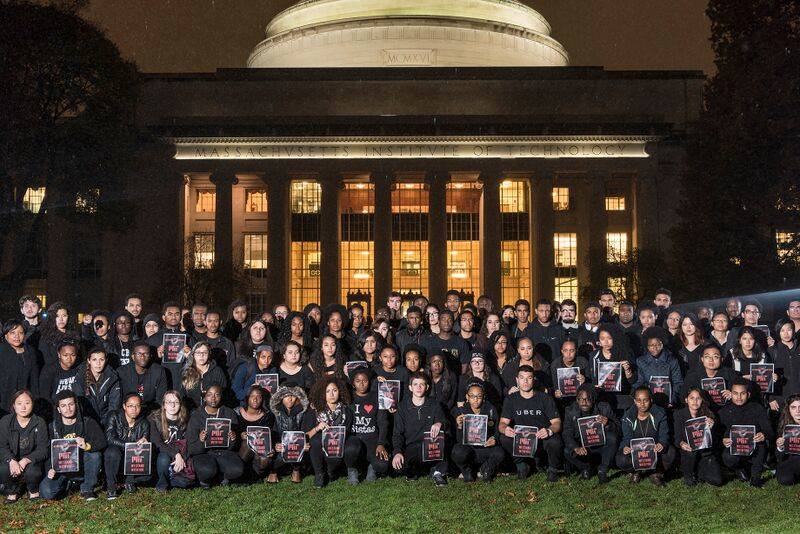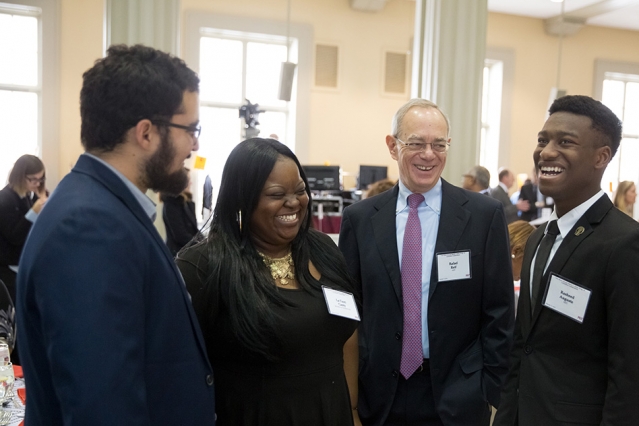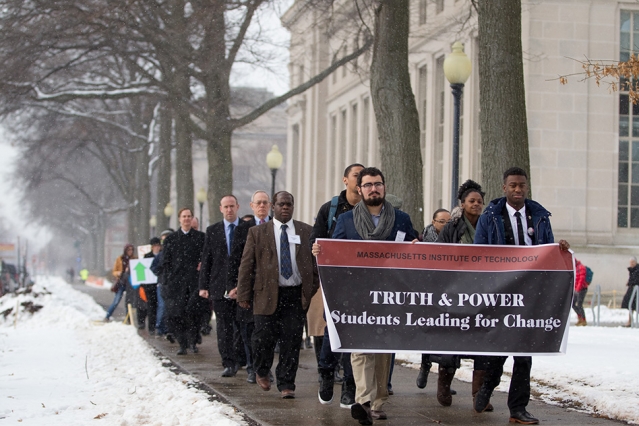The Latest Innovation at MIT by Selam G. '18
Guest Blog: Social engineering with the Black Student Union's Co-Chair, Rasheed A. '17
We often think of innovation as tied inherently to engineering and technology disciplines. We forget that innovation at its core really means solving problems in new ways, across many disciplines. Innovation means approaching the issues no one has dared to approach before.
We can take a hard look at many issues concerning the US and the world today and observe a theme: the United States’ 2016 election, police brutality, progress in the LGBTQ+ human rights movement, the flux of international refugees. It is clear that the most pressing, truly important problems we face are societal and social in nature. Therefore, we must address these problems with social innovation. We have to innovate, engineering the ways in which we communicate with each other, designing how we involve ourselves or get others involved.
In the great tradition of MIT, our undergraduates want to pioneer this innovation also, as we pioneered many others in the past.
In January I wrote a post, “Colors”, detailing the MIT community’s response to such events as the University of Missouri incidents in November (involving threats of physical violence to black students on campus), incidents at Yale, and general tension surrounding Ferguson and multiple police brutality instances. Rasheed A. ‘17 was an important member of that response. A friend of mine and the co-chair of the Black Students Union (BSU), he wrote this excellent piece detailing his and others’ involvements in creating a diverse, accepting environment at MIT. He led the creation of a list of recommendations to MIT administration that addressed the urgent needs of the large minority student population on campus, involving MIT faculty and administration in the cooperative manner I described in “Colors”. I am honored to present here this work, which can only be described as innovation.
Reflections of a BSU Co-Chair
A Year on the S. S. Recommendations
Rasheed Auguste
May 5, 2016
In my mind, every BSU Co-Chair had at least one major innovation during their tenure. Ikenna E. ‘15, helped start a yearly Black pre-frosh fly-in weekend for Ebony Affair — the Black community’s flagship gala. Last year, Grace A. ‘16, led MIT’s Black Lives Matter undergraduate response. However, I had no idea what my innovation was going to be when I stepped into the role. Then came the wave of events highlighted across college campuses such as the University of Missouri, Yale University, and Ithaca College.
For the first time since the Black Lives Matter movement last year, I felt exposed as the MIT bubble burst and the real world slipped in — social media posts of personal friends now mirrored national news headlines. This wave hit a bit too close to home.
Deciding to respond was simple. The first step to the Black Students’ Union’s official approach was solidarity. With the help of my BSU Political Action Committee (PAC), I began organizing a “Blackout at MIT”. Chris Welch even offered to take a professional photo outside Killian Court with all the supporters, pro bono. I could not have been more proud of my MIT Community as folks — familiar and unfamiliar — dressed in black, gathered in Lobby 10 on short notice and despite the drizzle, and stood silently for a photo. We had more allies than we thought.
The photo of supporters taken by Chris Welch ’13, M.S. ’15
Unexpectedly, an email from President Rafael Reif dinged into my inbox, asking to meet with executive board members of the BSU and Black Graduate Student Association (BGSA). It was validating to vent to the President of MIT about microaggressions, the pressure to defy stereotypes, and the seemingly numb indifference of our campus. His message was clear: “I [and by extension MIT] care deeply about the well-being of minority students.”
He left us with a call to action: “Is there any way you can send me a list of things I can help you with?” I brought the story to Alberto H. ‘17, my best friend and fellow Chocolate City brother, the BSU PAC, and the minority community. Initial thoughts included diverse mental health clinicians, expanded diversity orientation, survey questions on diversity and inclusion, and statements by department heads to affirm commitments to student health, diversity and inclusion.
We had seen other schools come up with demands lists, but they called for multicultural spaces, offices dedicated to minority students, and public statements of regret from institutions. These demands had already been met here or did not apply to MIT. For example, we have a BSU Lounge, an Office of Minority Education (OME), and an Office of Multicultural Programs (OMP). We did not think a public statement of regret would advance minority standing at MIT. Keeping this in mind, how could we move forward with an MIT-specific focus?
Alberto served on the Committee on Race and Diversity, co-chaired by the Institute Community and Equity Officer (ICEO) Edmund Bertschinger. Alberto mentioned the IECO put out a comprehensive report in February 2015. After some digging, he found the “Report on the Initiative for Faculty Race and Diversity” from January 2010. The 2010 report included some ICEO recommendations, and interestingly enough, a cover letter by Reif himself. Why had MIT gone to such lengths to commission a study on the advancement of diversity and inclusion and not implemented all the institute-specific solutions, twice? The plot thickened.
Using these two reports as a reference, we revised our list into recommendations. Alberto took an important step; he presented the incomplete list to the rest of the Committee on Race and Diversity (CRD) for feedback. We prepared down to the wire. 20 minutes before the meeting, we sat in Next House dining — Alberto in a suit and me in pajamas — putting the finishing touches on the draft.
Some of the list items affected specific committee members’ offices, and Alberto left the CRD meeting with recommendation-specific feedback. He was charged up. “Bro, we gotta make sure the things we ask for are feasible, specific to MIT, and someone will actually be responsible for making them happen!”
The next few days, we started playing Infinite Corridor pinball. Between classes, Alberto and I bounced from office to office and asked MIT staff, faculty, and students how to make sure specific recommendations would be most effective. Many meetings ensued:
Lydia Snover (Institutional Research) offered clementines and other goodies with her decades of expertise in creating insightful questions for institute surveys.
Jag Patel (Chancellor’s Office) laid out context for the recommendation to disaggregate survey responses by identity group (e.g. race, gender, sexuality) and to make this data public.
Dean Melissa Nobles (SHASS) told us of the wealth of existing classes that cover themes of diversity and inclusion.
Professor Krishna Rajagopal (Chair of the Faculty) helped us understand the GIRs and faculty influence on institute climate.
Elizabeth Young (Undergraduate Advising and Academic Programming) explained the planning process for Diversity Orientation.
Dean Stu Schmill ’89 (Admissions and Financial Aid) filled us in on financial aid and minority recruitment efforts.
Abigail Francis (Director of LBGT Services) gave key insight from previous LBGTQ+ student input on inclusion.
From left to right, Alberto H. ’17, Director of Mulitcultural Programs La-Tarri Canty, MIT President Rafael Reif, and Rasheed A. ’17, having a conversation before the annual Martin Luther King Luncheon.
We built their insights into accountability for the recommendations; together, we worked out who would be responsible for looking at changes and how to execute them.
We revised the list accordingly, and student feedback was still important. I held “Office hours” in the BSU Lounge to take in-person suggestions for the list. The PAC decided to give a more formal town hall style presentation to the minority community in the BSU Lounge, and we talked through specific items at length.
For instance, people had questions about the emphasis on departments, so we explained the strong influence of department climate on students’ experiences. It was important to not only invite the BSU to these conversations, but also other minority groups including the BGSA, Latino Cultural Center, and LBGT@MIT.
Feedback was not always so easy to receive. The day before the list went public, I presented to the UA Council, hoping to receive an endorsement on the recommendations. Council members meticulously deconstructed the document. They expressed opinions on everything from word choice and sentence structure to tone and rhetorical appeals. I wondered if the words we wrote truly blended the needs of the undergraduate students with impactful solutions. For the first time (but not the last), the ingredients of the recommendations were called into question.
The recommendations were still a work in progress when Professor Bertschinger emailed the BSU executive board asking us to formally present our sets of recommendations to Academic Council with the BGSA. Gulp. Presenting to the most senior leadership council at MIT including Deans, Provosts and Chancellors, Vice Presidents, and President Reif was not an opportunity to take lightly.
Parallel efforts by the BGSA, Black Alumni at MIT (who presented their own report with recommendations to administration in the Fall) made sure the work and advocacy was spread out. Presentation day came anyway.
As a student chosen to present to senior leadership at MIT, I felt it was important to project calm and confidence to everyone in the room. It was comforting to know my five other student presenters felt the same nervousness, even though we had rehearsed our roles beforehand. We were not alone though. We brought staff support with us: Dean DiOnetta Crayton (OME) and La-Tarri Canty (OMP).
Academic Council Members asked questions to learn more about our vision and process, and not to poke holes in our logic or narratives. Our reception was even warmer afterward. Associate Provost Richard Lester (former Nuclear Science and Engineering Department Head) came up to shake my hand, saying, “Thank you for your leadership in preparing the recommendations and in explaining them. As a member of the NSE faculty, I am very proud that an NSE student is leading this very important process.” I was certain folks in the room cared about our concerns and took our suggestions seriously.
Moreover, this high level of administration listened and internalized the extent to which they could help. Afterward, Vice President Kirk Kolenbrander convened a subgroup of Academic Council members to address the recommendations of the BSU and BGSA. He opened with, “Over the course of my career at MIT, there have been a few moments when I have said to myself, ‘This is going to be really important for changing the future of MIT.’ Your presentation to Academic Council was one of them.”
The Black Students’ Union List of Recommendations for MIT Administration went public on December 9, complete with a URL (recommendations.mit.edu) and News Office story.
The article about the recommendations, featured on the MIT News page.
Afterward, we worked with many offices to implement solutions. Chancellor Barnhart worked with Alberto, Lydia Snover’s office, and I to expand questions on diversity and inclusion into institute-wide surveys. MIT Mental Health hired a full-time, African Diaspora specializing, mental health clinician. Department Heads of Math, Physics, and History started writing commitments to health, diversity, and inclusion.
Feedback on our work was still important. During an OME Faculty Advisory Committee meeting, Professor Wes Harris politely asked the BSU executive board, “What does your first recommendation [on mental health] mean?” We offered him an explanation. He asked again, “Let me rephrase, how will you know when it’s finished? How will you know when all of your recommendations are addressed? What will MIT look like?”
As we struggled to produce a substantive answer, I was floored. I had been focusing on details and specific recommendations for so long, I was afraid I had lost sight of that big picture. What is MIT supposed to look like? I still struggle to answer this question substantively.
Delivering a firm, Professor Harris handshake, he warned Alberto and me, “I’ve seen students lose their minds over this. Make sure you take care of yourself.” Taking a step back, it was important to make sure the burden of advancing the efforts of the list did not fall directly on students.
Supportive staff made sure this was not the case. Dean Crayton would press, “How are you?” “I’m okay.” “No, how are you doing, really?” After a long week in November, La-Tarri Canty asked Alberto and me, “You both need a break. What are you doing this weekend?” He replied, “We’re going to Connecticut for the Harvard-Yale Game. Punching out until Monday.” Staff members and other groups even developed their own set of recommendations for administration, further supporting our efforts.
Through months of hard work, student leaders such as Alberto and I have been blessed also to receive recognition for our efforts from the community, including President Reif, the MLK Celebration Subcommittee of the CRD, and the OMP.
After all, they say MIT is a journey, but this year felt more like a voyage. Commissioned by President Reif himself, we set out on S.S. Recommendations. The sails were driven by gusts of MIT community feedback, waves were filled with self-doubt, and our trusty crew was comprised of friends, supporting staff, and faculty. Navigating through new spaces and working with new people left us with invaluable communication skills that could not be learned in a classroom. All this time, we struck a difficult balance between hard work and self-care.
My mother says, “You gotta love people where they’re at.” As MIT is swiftly moving to address the BSU recommendations and more, I remember her words to remind myself to advocate for collaboration across all levels (e.g. students, faculty, staff, alumni, Corporation members), not negotiation. MIT has the opportunity to become the example for diversity and inclusion efforts in research environments and higher education. I look forward to Fall 2016, eagerly waiting for what we, MIT, do next.



